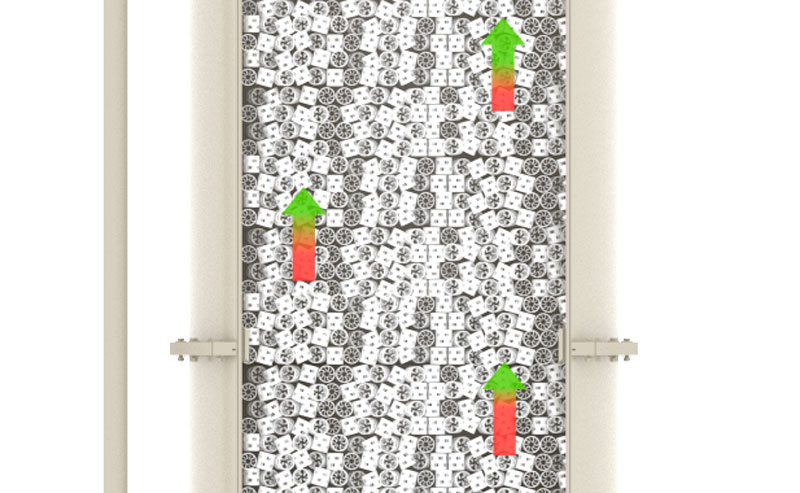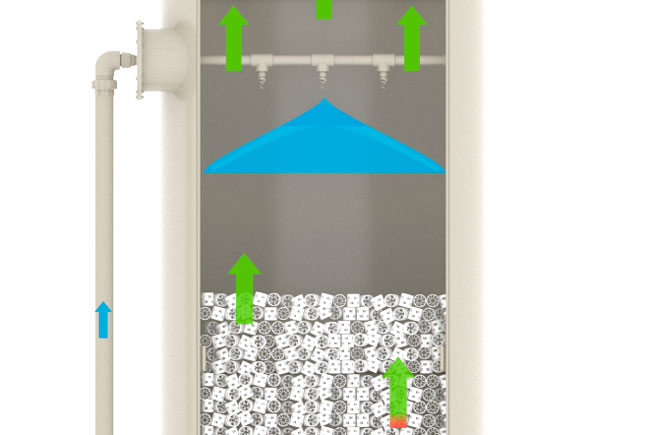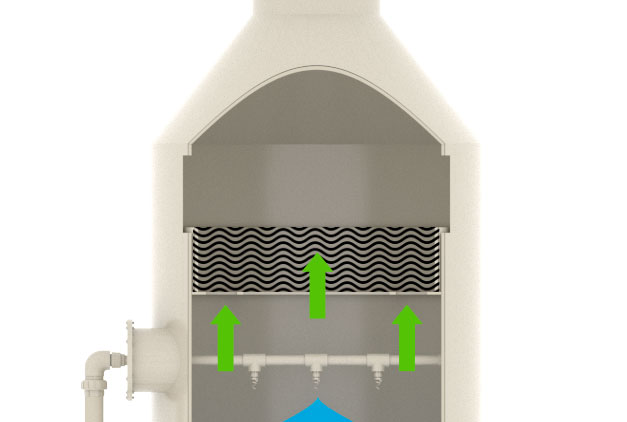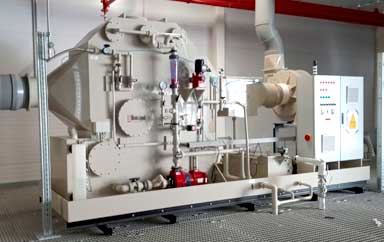At Quimipol we design, manufacture and install high-efficiency gas scrubbers for the purification of industrial emissions.
Also known as scrubbers or washing towers, these equipment are essential to ensure that industrial processes comply with the most demanding environmental regulations. But how exactly does a gas scrubber work? We explain it step by step.
-
Ingress of contaminated gas
The process begins at the base of the gas scrubber, where the contaminated air flow is introduced. This gas usually comes from industrial processes such as chemical reactions, combustion or heat treatments, and can contain harmful substances such as hydrogen chloride (HCl), sulphur dioxide (SO₂) or organic vapours (VOCs).
The design of the inlet system is optimized to ensure a constant and uniform flow, allowing the gas to rise in a controlled manner through the interior of the scrubber.
-
Fill bed
Once the gas begins to rise inside the washer, it passes through the so-called filler bed, made up of technical elements known as Pall rings. These rings are specially designed to maximise contact between the gas and the washing liquid, which is key to efficient purification.
Thanks to their open structure and large specific surface area, Pall rings divide the gas flow into multiple streams, facilitating a homogeneous distribution. This design allows continuous contact between the two phases (gas and liquid) and avoids common problems such as bed clogging, even under demanding working conditions.
-
Spraying the washing liquid
At the top of the gas scrubber is the spray system, which consists of a network of distribution nozzles that are responsible for applying the washing liquid evenly to the filling bed.
This liquid can be simply water, in the case of soluble contaminants, or a neutralizing chemical solution such as sodium hydroxide (NaOH) or lime milk, if the gas contains acidic or more aggressive components.
When it falls on the Pall rings, the liquid coats its surface forming a thin liquid film, ready to capture, dissolve or neutralize the contaminants present in the gas as it ascends the tower.
-
Reaction and absorption of pollutants
At this point, the main action of the gas scrubber occurs: the capture and elimination of pollutants. As the gas rises and comes into contact with the liquid film that covers the Pall rings, a chemical or physical exchange occurs between the two phases.
Depending on the type of contaminant, the mechanism may vary:
- Soluble gases, such as ammonia (NH₃), are dissolved directly in the liquid.
- Acidic gases, such as hydrogen chloride (HCl) or sulphur dioxide (SO₂), react with basic substances present in the washing solution, resulting in harmless and stable salts.
The scrubber design and the efficiency of the fill bed ensure that this process is consistent, uniform and highly effective, even under varying operating conditions.
- Drop Retainer (Demister)
Before the already purified gas leaves the scrubber, it passes through an essential component of the system: the droplet retainer, also known as the demister.
This device acts as a physical barrier that captures any liquid particles that may have been left in suspension, preventing them from being dragged by the gas on its way out. Thanks to its internal design, the demister ensures a dry, clean and residue-free emission, complying with the environmental and air quality standards required by the regulations.
-
Recirculation and control of the washing liquid
Once the liquid has captured the contaminants present in the gas, it descends to the base of the scrubber. This is where a key process for the efficiency of the system begins: the recirculation and continuous treatment of the washing liquid.
This circuit incorporates several fundamental elements:
- Recirculation tank, where the liquid already used is collected and stored.
- Recirculation pump, which pushes the liquid back to the top of the washer, allowing it to be reused.
- pH sensor, which monitors the level of acidity or alkalinity in real time, adjusting the system as necessary.
- ⚡ Conductivity meter, which measures the accumulation of salts and by-products, indicating when to renew part of the liquid.
- ⚙️ Automatic dosing pump, which corrects pH by precisely adding chemicals, such as acid or base.
This automated system allows the liquid to be kept in optimal conditions, extends its service life and ensures that the gas scrubber operates stably and efficiently throughout the process.
Why choose a Quimipol gas scrubber?
At Quimipol we design much more than equipment: we offer complete technical solutions, designed to be effectively integrated into real and demanding industrial processes.
Our gas scrubbers stand out for their:
- Modular design, adaptable to different configurations and spaces.
- Advanced automation, ensuring accurate and consistent operation.
- Robustness and durability, thanks to the use of high-quality anti-corrosion materials.
All this makes them a key tool for companies looking to reduce their emissions in a safe, efficient and sustainable way.
Visit our Gas Scrubbers homepage
Contact us and discover the ideal solution for your industry or laboratory.
———————————–
About the Author
Sergi Vinuesa – Sales Manager at Quimipol








